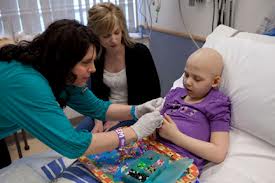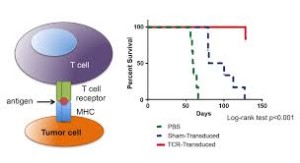
Medical experts state that new latest experimental therapy has brought consistent remissions to a high proportion of patients that were prone to death due to high level leukemia after all the basic and set-standard cures have turned a fiasco. The therapy involves genetically programming cells from the patients own immune system to fight the disease.

The research included 30 patients: five adults ages 26 to 60, and 25 children and young adults ages 5 to 22. All were severely ill, with acute lymphoblastic leukemia, and had relapsed several times or had never responded to typical therapies. In more than half, the disease had come back even after a stem-cell transplant, which usually gives patients the best hope of surviving. Their life expectancy was a few months, or in some cases just weeks.
Six months after being treated, 23 of the 30 patients were still alive, and 19 of them have remained in complete remission.
The study, by researchers at the Childrens Hospital of Philadelphia and the Hospital of the University of Pennsylvania, is being published in The New England Journal of Medicine.
Photo
Tiny magnetic beads force the larger T-cells, an immune cell, to multiply to produce more cancer-killing cells. Credit Penn Medicine

We have a number of patients who are a year or more out and are in remission and not requiring other therapies, said Dr. Stephan A. Grupp, who led the part of the study done at Childrens Hospital of Philadelphia. He said those long remissions gave the researchers hope that the treatment would have lasting effects.
Earlier reports by the same researchers involved only a handful of patients, some with chronic rather than acute leukemia. The scientists say the growing number of patients treated helps demonstrate that the findings are real.
With the initial patients, we didnt know if it was just lucky, said Dr. Carl H. June, the director of translational research at the universitys cancer center. It turns out its reproducible.
He and Dr. Grupp said that other hospitals around the country would soon test the experimental treatment in children with advanced acute lymphoblastic leukemia.
Similar research, also with encouraging results, is being done at other centers, including the National Cancer Institute and Memorial Sloan Kettering Cancer Center in New York.
Each year in the United States, acute lymphoblastic leukemia affects about 2,400 people older than 20, and 3,600 younger. It has a cure rate in adults of only about 40 percent, compared with 80 percent to 90 percent in children. About 1,170 adults die from the disease each year, compared with 270 people under age 20.
The experimental treatment uses patients own T-cells, a type of immune cell. Researchers extract the T-cells and then genetically engineer them, using a disabled virus to slip new genetic material into the cells. The new genetic material reprograms the T-cells to recognize and kill any cell that carries a particular protein on its surface. Then the cells are dripped back into the patient, like a transfusion.
The cells are also programmed to multiply, so that each one can yield as many as 10,000 more cancer-killing cells.
The protein they search for, called CD19, is found on B-cells, which are also part of the immune system. It was chosen as the target because these patients have a type of leukemia that affects B-cells, so the goal is to train the patients T-cells to destroy B-cells. Healthy B-cells ” which make antibodies to fight infection ” are killed along with cancerous ones, but that side effect is treatable.
The treatment clearly does not work for everyone. Seven of the 30 patients died, including a few who had complete remissions at first and then relapsed. In three, the leukemia came roaring back in B-cells that lacked the target protein and therefore were not vulnerable to the treatment.
Even so, Dr. June described the effectiveness of the treatment as beyond my expectations.
Of the 19 patients who stayed in remission, 15 did so without any additional treatment. One of them is Emma Whitehead, now 9, who was treated more than two years ago.
Some researchers have thought that, to be on the safe side, any patient who went into remission after T-cell treatment should have a stem cell transplant, because stem cells are considered the standard of care for this type of leukemia. But Dr. June and Dr. Grupp said the long remissions suggested that transplants might not be needed. They hope that eventually the T-cell treatment will be used instead of stem cell transplants, which are risky and arduous.
But the T-cell treatment has its own side effects, in particular a phenomenon known as cytokine release syndrome. It occurs when the T-cells churn out hormones called cytokines that can cause fever, aches, drops in blood pressure and breathing trouble. The more cancer there is to destroy, the worse the syndrome, Dr. June said.
Dawn Carie, from Chesterfield, Mich., said her daughter, Lexie, then 16, had the T-cell treatment a year ago, after multiple types of chemotherapy and a stem-cell transplant had failed. Within hours of receiving the T-cells, Lexies temperature shot up to 105 degrees, and she became disoriented and had frightening hallucinations. But when it was all over, she was in remission. For the first time since Lexie was 2, her mother said, tests found no signs whatsoever of leukemic cells.
Because her disease had been so severe, Lexie had two more infusions of T-cells a few months after the first one. She remains in remission.
Lexie is now a senior in high school, busy applying to colleges, Ms. Carie said, adding, You know, its odd to feel normal, because we really never have.
In July, the Food and Drug Administration designated the T-cell treatment a breakthrough therapy for relapsed and treatment-resistant acute lymphoblastic leukemia in adults and children. The designation recognizes experimental drugs that may demonstrate substantial improvement over existing therapies for life-threatening conditions, and is meant to speed their development and review.
As of now, the patients T-cells are processed at the University of Pennsylvania. However, the drug company Novartis, which helped pay for the study, has offered and given huge amount in the research, has licenses to the technology and is also expected to take over the cell processing. Some famous authors including Dr. June, Dr. Grupp and other researchers generated the technologies and may now benefit from them.
Be a part of Elets Collaborative Initiatives. Join Us for Upcoming Events and explore business opportunities. Like us on Facebook , connect with us on LinkedIn and follow us on Twitter , Instagram.













